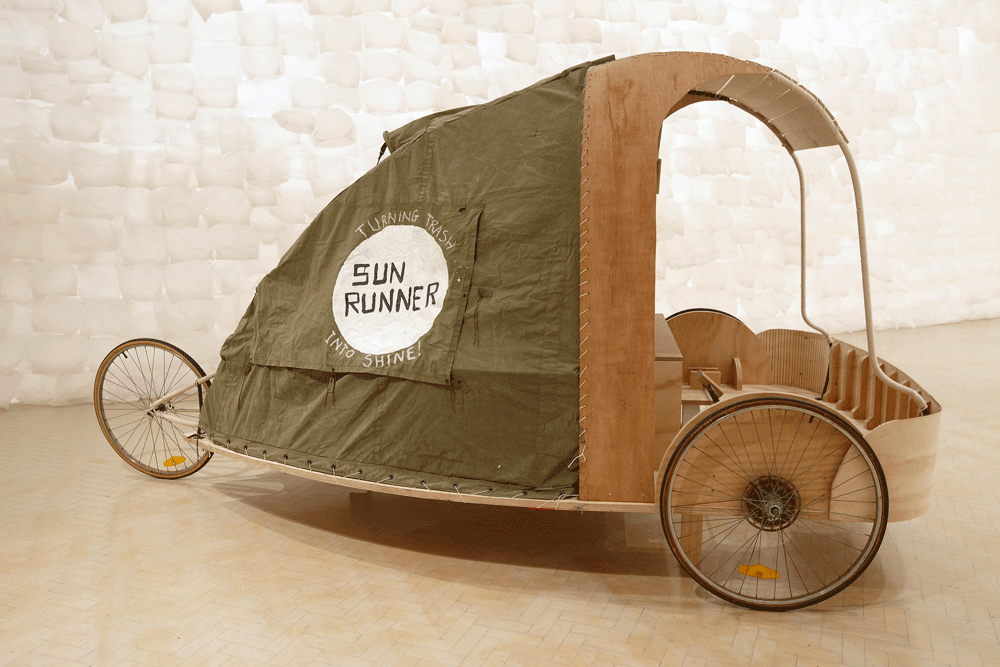In the Balance
Museum of Contemporary Art, Sydney, Australia
Museum of Contemporary Art, Sydney, Australia

‘In the Balance: Art for a Changing World’ was presented as an exhibition about the environment: specifically, the plight of Australia’s waterways (such as the Murray Darling Basin), the history of environmental activism (with a focus on Tasmania), the impact of human practices on oceans and land (like Cape York) and the ways artists encourage societal change. For the most part, the 30 artists and collectives included here successfully demonstrated the extent to which the environment has become politicized, and how specific concerns regarding wildlife, ecology and biodiversity have been packaged under the single, generalized slogan of ‘Save the environment!’
It is a neat coincidence that ‘In the Balance’ opened the weekend Australia went to the polls to elect a new government, returning a hung parliament – the first in 70 years. With the major parties in limbo, a Green Party MP and four independents – one from Tasmania (the birth place of the Australian Greens movement) and three from rural Australia – became the kingmakers. While eventually siding with Prime Minister Julia Gillard and Labor, it was clear that environmental issues were key in their negotiations. (If you doubt how strongly Australians feel about the environment, then remember that former prime minister Kevin Rudd was ousted following his failed bids to push through a carbon emissions trading scheme and a tax for the mammoth mining corporations making a fortune from natural resources in Australia.)
Similar prompts for political change were echoed in the Wilderness Society’s 1980s publicity material produced to support the campaign against the Franklin River Dam project, displayed as part of ‘In the Balance’. Tasmanian photographer Peter Dombrovski’s work, Morning Mist, Rock Island Bend, Franklin River, Southwest Tasmania (1979), is the focal point of this material. Used to illustrate posters (which were displayed in frames at the Museum of Contemporary Art), pamphlets and magazine covers, the image celebrates the very best of the Romantic landscape tradition: the photo shows the river as pristine and wild. When paired with the slogan ‘Mr Fraser won’t save it. Your vote can’, it became a symbol that precipitated the downfall of Malcolm Fraser’s Liberal Government.
Some collectives did particularly well embracing the term ‘eco-art’. Victoria-based Artist as Family, for example, grew a productive cottage vegetable garden (Food Forest, 2010) on the grounds of an inner-city Sydney church, as an ode to William Blake’s Garden of Love (1794). Amy Francheschini and San Francisco-based design-art collective FutureFarmers (the designers of the Twitter logo) made a prosaic construction out of plywood that was intended as a solar-power still using compost to create engine-ready bio-fuel (Sunshine Still, 2010). It seemed to founder in its functional purpose, but showed their urban eco-ideology well.
Janet Laurence makes fragile, clinical sculptures of specimens from rainforests suspended in glass vials to highlight the fragility of plant systems. Coupled with a split screen projection (Vanishing, 2009) showing close-up frames of animal skin quivering and pulsing, filmed while completing a residence at Taronga Zoo in Sydney, the installation Cellular Gardens (where breathing begins) (2005) hammered at our perceptions of nature. Laurence illustrates how a single disruption in a fragile ecological balance can be catastrophic. Specimens will die; species will die. The curators’ decision to position the piece directly outside the lifts, the least environmentally friendly access option, was also notable.
Laurence’s work – like that of Bonita Ely’s delicate but charged photo etchings of the Murray River (The Rivers Edge, 1979), Emily Floyd’s complex ‘70s-slogan-inspired etchings (It’s Time, 2008) and Lorraine Connelly-Northey’s wondrous floor-to-ceiling-scrap metal sculpture My Three Rivers Country (2010) – elevated ‘In the Balance’ above the realm of political servitude and hip culture. The same can be said of the surprising but inspired inclusion of the short film Franklin River Journey (1980) by the respected Australian film director, Robert Connelly. The film tracks amateur botanist Antonius Moscal as he navigates the wilds of the Franklin River, mumbling evocations of God that are only audible thanks to a voice-over by actor John Bluthnal. To the sound of choral music, Moscal is beaten, humbled and belittled by the rapids and the harsh surrounds. When a tourist boat comes into view he scrambles aboard. As the captain of the boat recites information on the proposed dam project that would destroy the wild river, Moscal is unresponsive. He gazes out the window, as if implying, ‘Take the river’. Connelly unintentionally reveals the core of much of the art included in this exhibition by way a proclamation on the wall panel: ‘In essence [it is] an advocacy film. The first and last one I ever made – a propaganda film essentially.’
























